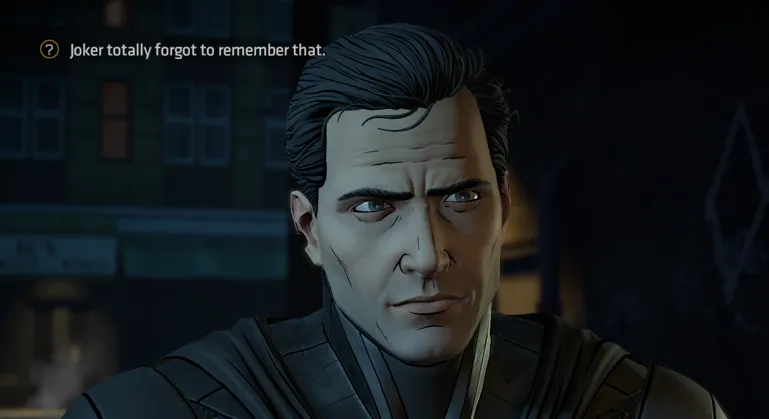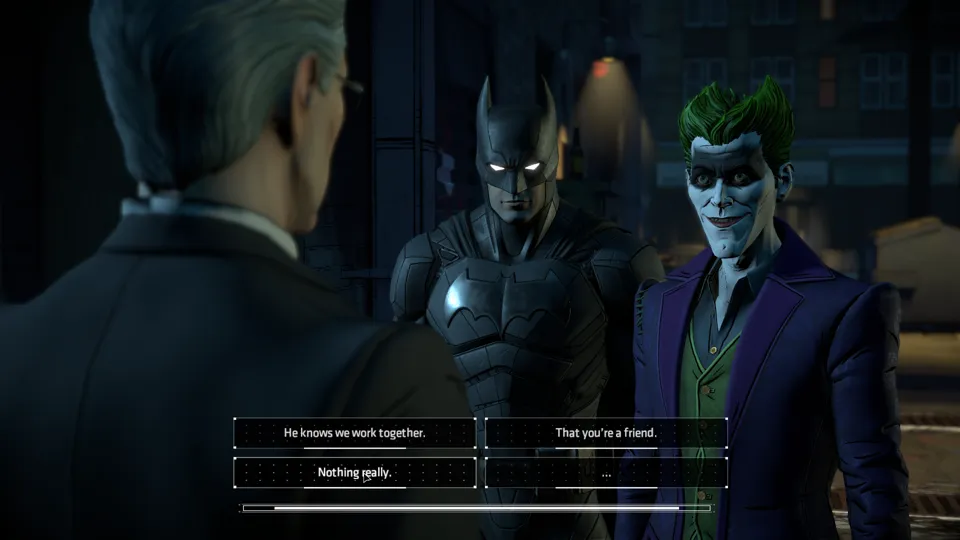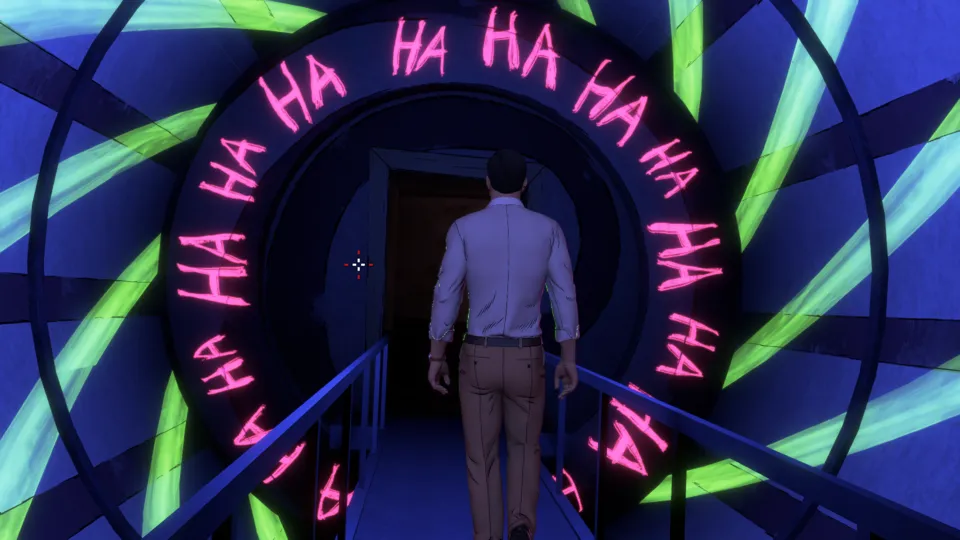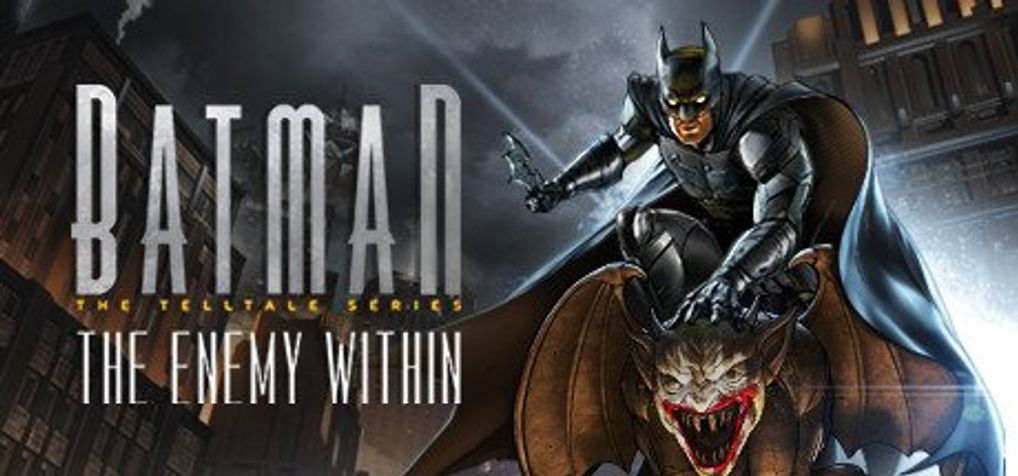Batman Enemy Within
I love Telltale games. They’re fun, they tell their story well, and they let the player engage with the characters in a way that’s unique. Looking at achievement statistics for these games, once people pick them up, people tend to finish them. They’re engaging and compelling, and I understand why.
I almost couldn’t finish this one.
 I’ll explain, promise.
I’ll explain, promise.
Batman: The Enemy Within is a direct sequel to Batman: The Telltale Series . The mechanics are the same; you play as Bruce Wayne, navigating the intricacies of being both Bruce Wayne and Batman while trying to stop Gotham’s criminals from taking over the city. It’s a point and click adventure more akin to a choose your own adventure book than a traditional game, but that’s part of the appeal. It’s a game whose atmosphere and story drive the player forward, and it excels at it.
 Example of a decision point
Example of a decision point
In this adventure, Batman is investigating the mysterious Pact, a new group of supervillains who have come to town for mysterious reasons. Batman must find the Pact’s motivations and stop them, all while balancing interactions with the Agency, a shadowy group who seem very happy to blackmail Batman into co-operation. It’s a more complex and difficult story, and the decisions that Bruce Wayne makes along the way aren’t comfortable ones.
 Except this one. Easiest decision ever.
Except this one. Easiest decision ever.
A more difficult and emotionally heavy game isn’t a bad thing. As I’ve previously discussed , a big part of the appeal of games is the sense of escapism and ability to explore ideas and emotions that you might otherwise not be able to explore, or to explore them in a safe space. Grappling with tough moral choices is something I enjoy in games, and The Enemy Within is no different.
This immersion into escapism fails, though, when the character I’m directing and I fundamentally disagree, and the game provides no avenue to explore that. This is always the risk with interactive novels. Unlike a game where the main character is a completely blank slate, Bruce Wayne is an established character. He has a backstory, his own motivations, and an expectation of what he’ll do. The plot of this game also has its expectations, and much as discussed in the previous review of this series, there are beats it will always hit and fences around our playground of choice. I have no objection to the fences. It’s not possible for a game with a structured plot to leave room for all of the multitudes of choices I could make, and even within this space, Telltale does a fantastic job accommodating a vast range of possibility.
Except the important one.
 A screenshot from Batman Enemy Within
A screenshot from Batman Enemy Within
There comes a moment where Bruce Wayne has to choose between continuing his infiltration of the Pact and putting Catwoman at risk. I played through both games, carefully cultivating a relationship with Catwoman, and when this moment came up, I misclicked. I accidentally condemned her.
On the surface, I wouldn’t be broken over this. A misclick is a misclick, and to a certain extent, I can chalk it up to Bruce Wayne being different than me and reasoning through things differently. I was upset, but not willing to put the game aside.
In the final act, though, the true repercussions of that misclick became clear. Telltale Games reshape the story based on the decisions the player makes. Characters are removed or relocated based on those decisions, and the story reforms around the bedrocks of these decision points, ripples and all. The consequence of my misclick became very clear in the last act. In the final act, it’s revealed that the Agency has been accumulating super villains to form a super squad, enslaving them using shock collars and control devices. To a comic book reader, this might have been inevitable, but to me, seeing the character I had so carefully cultivated a relationship with, enslaved, was horrifying. On a gameplay and narrative level, it’s a great opportunity for character building. What does a character do when they find someone they care about subjected to such a visceral horror? How does the character save them? How can I save the day?
And the answer, quite simply, is that I don’t. Batman politely asks that Catwoman be freed, and when she is not, that is the end of the discussion. Catwoman is left to be subjected to one of the greatest horrors I can imagine, and Batman does nothing.
I found the fences surrounding my decision-making ability, and as much as I railed against them, they could not be broken.
It would be one thing if there was any indication that the character agreed with me, but Batman seems okay with this as a punishment. The idea of a lifetime of torture is okay by Batman, whatever decisions the player has made to the contrary along the way. This is the moment I nearly closed the game. This moment, where the game developers’ thoughts shone through brighter than the actual story, this is the moment where I was viscerally ejected from the game.
A game like Enemy Within succeeds when the player is able to find themselves in the story. There is no part of me that will ever be able to find myself in a game that actively advocates slavery and torture as an appropriate retribution for robbery, and it is appalling that the writers thought I would. That there is no option to stop arguably the biggest villain in the game says volumes about how the writers view crime, punishment, and policing.
I’m playing this in 2021. That I participated in the BLM protests in my city is no secret . That I continuously and passionately advocate for social justice is no secret . I am a person who has thought long and hard about systemic violence, racism, and what an appropriate police response actually looks like. Games offer a chance to explore a perspective and understanding we might otherwise never see, and Enemy Within does exactly that. It gives me the perspective of someone who agrees with the current state of policing, and maybe thinks it should go further.
And that that is the foundation undergirding this entire game ruins the entire game.
There are moments where the game is self-aware, where characters realise Bruce is using them, and lament that fact, but there is no opportunity to learn or do anything different. It is a slog of abuse ending in torture, with no consequences for the torturer. If the game made this seem like a bad thing, that would be more acceptable, but as the head of the Agency walks away, her enslaved criminals in tow, the triumphant music swells, and we are meant to understand that we have won.
We have not. We absolutely have not.
I want to understand why this game is the way it is, but I don’t believe I ever will. Most of the game is an interesting exploration of grey morality and the difficulty of being a hero without knowing the consequences of your actions. I love that, and to see it get thrown away in the last act with an uncounterable position that an action taken by a law enforcement authority is justified because they are law enforcement is baffling. It speaks to the hollowness of the game, that as much as there is to explore, we are ultimately in a funnel with the walls of choice serving only to feed us down to the inevitable conclusion that the game wants us to have.
Developer: Telltale Games
Genre: Graphic Novel, Adventure
Year: 2017
Country: United States
Language: English
Play Time: 9.5 Hours
